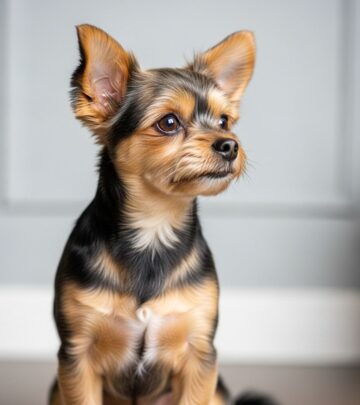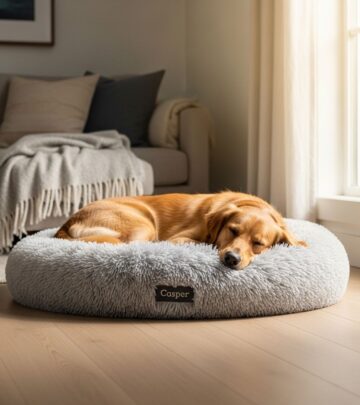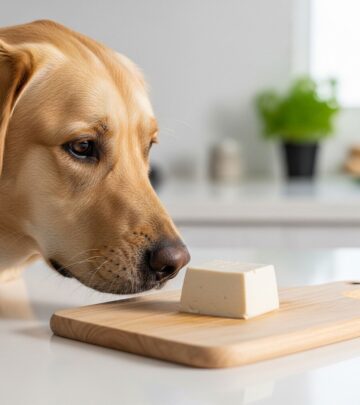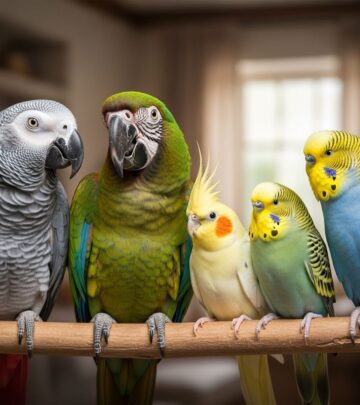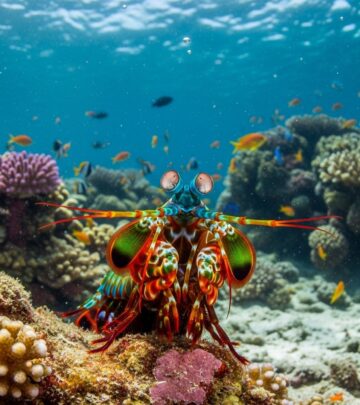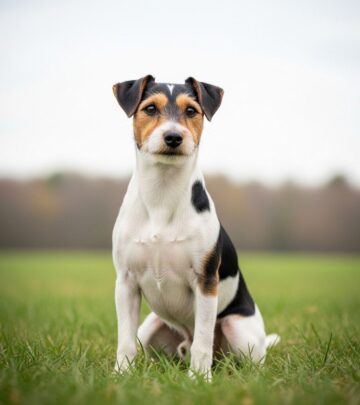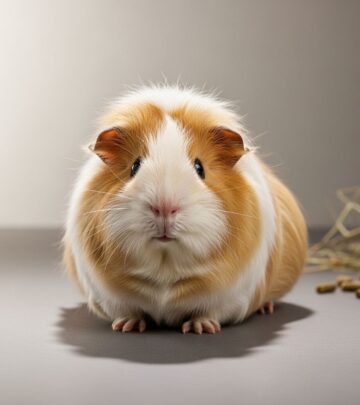Scottish Deerhound: Comprehensive Guide To This Gentle Giant
Discover the noble Scottish Deerhound, a graceful giant with an ancient lineage and gentle demeanor
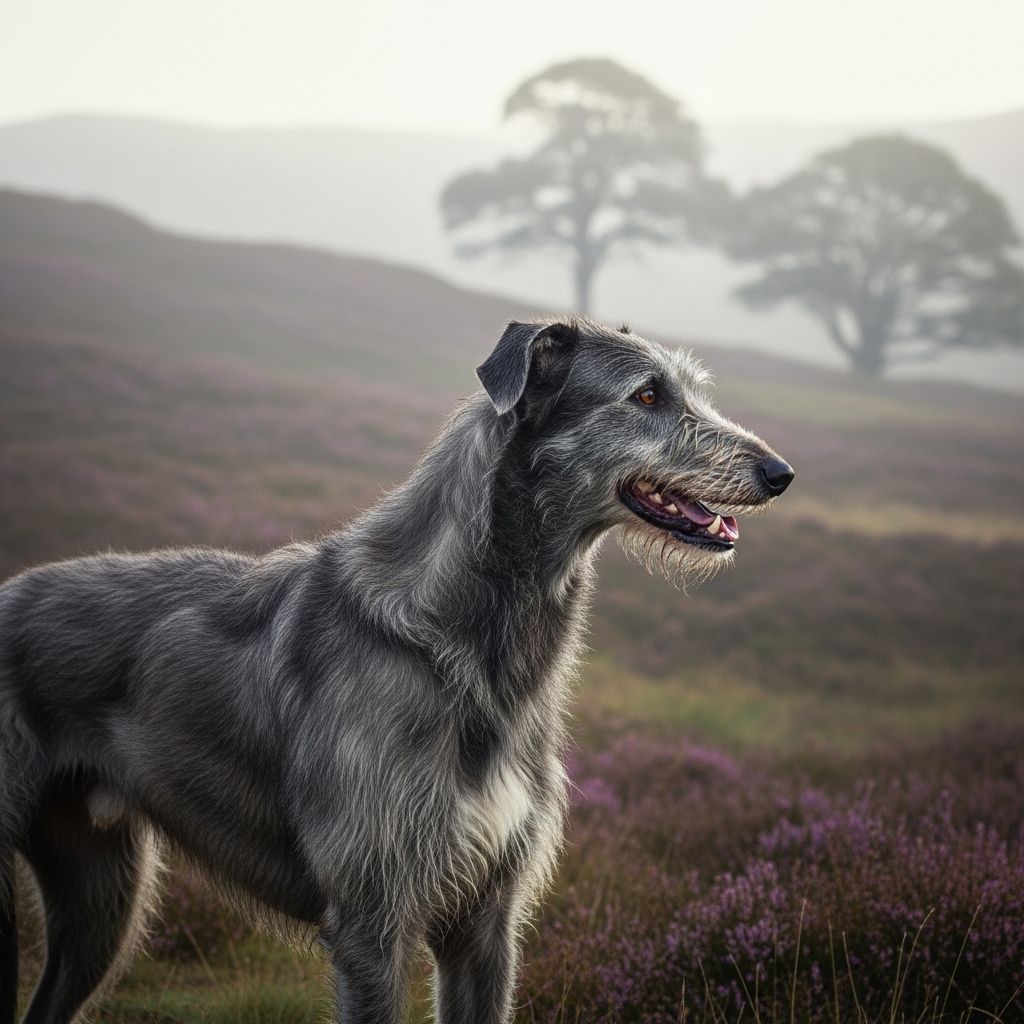
Image: HearthJunction Design Team
Scottish Deerhound: An Ancient Breed with Royal Heritage
The Scottish Deerhound stands as one of the most dignified and majestic of all canine breeds. Originally bred to pursue deer in the Scottish Highlands, this noble sighthound has been described by Sir Walter Scott as ‘the most perfect creatures of Heaven.’ With a lineage that stretches back centuries, the Scottish Deerhound combines impressive size with graceful elegance, creating a breed that truly commands attention while maintaining a gentle, easygoing nature.
These magnificent hounds have been prized by royalty and nobility throughout history, and despite their hunting origins, have successfully transitioned to becoming beloved companions in modern homes. Their dignified bearing and loyal temperament make them a distinctive choice for those seeking a large breed with a noble character.
Breed Characteristics
The Scottish Deerhound is a large sighthound breed with a distinctive appearance that has remained remarkably unchanged for centuries. Devoted breed enthusiasts have carefully preserved the standard, ensuring today’s Deerhounds closely resemble their ancestors who hunted in the Scottish Highlands generations ago.
Appearance
Scottish Deerhounds resemble a rough-coated Greyhound of larger size and bone. They are slightly longer than tall, with good bone structure and muscle, covered by a harsh, ragged coat that gives them a natural, rustic appearance. Their overall bearing conveys an air of quiet dignity that is characteristic of the breed.
The head of a Scottish Deerhound should be broadest at the ears, narrowing slightly to the eyes, with the muzzle tapering more distinctly. This creates the noble, aristocratic expression that is so valued in the breed. Their dark eyes should be moderately full with a soft expression when at rest, but alert and eager when excited.
Standing between 28 to 32 inches tall at the shoulder and weighing between 75 to 110 pounds, Deerhounds are among the tallest of dog breeds. Males are typically larger and more substantial than females, but both possess the same graceful outline and dignified presence.
Coat and Color
The Scottish Deerhound’s coat is harsh and wiry, providing protection from the harsh Highland weather. The coat is typically 3-4 inches long on the body, with longer furnishings on the neck and back of the thighs. While blue-gray is often considered the classic color, Deerhounds also come in other shades of gray, fawn, yellow, sandy, or brindle patterns. Pure white markings on the chest, feet, or tail tip may appear but should be minimal.
The rough coat requires only moderate grooming, with weekly brushing usually sufficient to remove loose hair and prevent matting. Their natural, somewhat tousled appearance is part of their charm and should be preserved rather than over-groomed.
Temperament and Personality
Despite their imposing size, Scottish Deerhounds are known for their gentle, easygoing temperament. They are adaptable, polite, and affectionate with their families, returning the love and care their owners provide with steadfast loyalty. While reserved with strangers, they are never aggressive without cause, displaying a dignified aloofness rather than suspicion.
With children, Deerhounds are typically excellent companions, though their size means interactions with very young children should always be supervised. They may sometimes play roughly due to their size, but they are not intentionally boisterous and generally maintain a calm demeanor indoors.
As sighthounds, Deerhounds possess an independent streak characteristic of hounds bred to think for themselves while hunting. This independence doesn’t diminish their devotion to their families—in fact, despite their grand size, many Deerhounds try to squeeze into the smallest spaces to be close to their beloved owners.
History and Heritage
The Scottish Deerhound’s history is deeply intertwined with the rugged Scottish Highlands and the nobility who once ruled there. Originally bred to pursue and bring down deer, these magnificent hounds were so prized that for a time, no one of rank lower than an earl was permitted to own them, earning them the nickname ‘Royal Dog of Scotland.’
Archaeological evidence suggests similar large sighthounds existed in Scotland as early as the 1st century CE, though the breed as we know it today likely developed between the 16th and 18th centuries. They were essential to Highland chieftains and clan leaders, who relied on them not only for sport but for providing venison for their tables.
The breed faced a crisis in the mid-19th century when Highland deer forests were broken up, and the clan system collapsed following the Battle of Culloden. Fortunately, dedicated enthusiasts stepped in to preserve these noble hounds. The transition from working hunting dogs to show dogs came surprisingly easily for the breed, with Deerhounds being exhibited at one of Britain’s first dog shows in London in 1859.
The American Kennel Club recognized the Scottish Deerhound in 1886, and the original AKC standard was taken almost verbatim from the English version of the late 19th century. Remarkably, the current standard has remained unchanged since 1935, a testament to the breed’s timeless qualities.
Living with a Scottish Deerhound
Bringing a Scottish Deerhound into your life means welcoming a gentle giant with specific needs and considerations. Understanding their exercise requirements, training approach, and living space needs is essential to providing a fulfilling life for these majestic hounds.
Exercise and Activity
Scottish Deerhounds need regular exercise to maintain their physical and mental health. As former deer hunters, they have a strong instinct to run and chase, requiring secure, fenced areas where they can safely stretch their legs. Daily walks are necessary, but they also benefit greatly from opportunities to run freely in secure areas.
While energetic outdoors, Deerhounds are typically calm and quiet indoors, often content to lounge on soft surfaces watching household activities. This indoor/outdoor balance makes them adaptable to various lifestyles, provided their exercise needs are met.
It’s important to note that as sighthounds, Deerhounds have a strong prey drive and will instinctively chase moving objects. For this reason, they should always be kept on a leash when not in securely fenced areas, and care should be taken around smaller pets they might view as prey.
Training and Socialization
Scottish Deerhounds are intelligent but independent thinkers, characteristics that served them well as hunting hounds but can present challenges in training. They respond best to positive, reward-based methods and gentle consistency. Harsh corrections or repetitive drills will likely be met with dignified refusal rather than compliance.
Early socialization is essential for Deerhounds to develop into well-adjusted adults. Exposure to various people, environments, and situations helps them become confident and adaptable. Their natural reserve with strangers shouldn’t be confused with fearfulness—a well-socialized Deerhound is calmly aloof rather than timid or aggressive.
While not typically competitive in obedience trials, Deerhounds can excel in lure coursing, a sport that allows them to use their natural hunting abilities in a controlled environment. Many also enjoy casual agility training, which provides mental and physical stimulation while strengthening the bond between hound and owner.
Living Environment
Despite their large size, Scottish Deerhounds can adapt to various living situations provided they receive adequate exercise. While they naturally thrive in rural settings with room to run, they can adjust to suburban living with access to secure exercise areas. Their calm indoor demeanor makes them better suited to apartment living than many smaller, more energetic breeds, though space constraints remain a consideration.
Deerhounds do best with access to soft surfaces for resting, as their lean build offers little natural padding over bony prominences. They typically enjoy the company of other dogs, especially other sighthounds, though males may occasionally display dominance toward other male dogs.
Climate is an important consideration for Scottish Deerhounds. Their lean bodies and thin coats provide limited insulation against extreme cold, while their size makes them vulnerable to heat stress. Access to climate-controlled indoor spaces is essential in both hot and cold extremes.
Health and Care
Like all purebred dogs, Scottish Deerhounds have specific health considerations prospective owners should understand. While generally healthy, they are prone to certain conditions that affect large, deep-chested breeds.
Gastric torsion (bloat) is perhaps the most serious acute health concern, a life-threatening condition requiring immediate veterinary intervention. Owners should familiarize themselves with the symptoms and preventive measures, including feeding smaller meals and avoiding exercise immediately after eating.
Cardiac issues, particularly dilated cardiomyopathy, can affect the breed, as can certain bone and joint problems common to large dogs. Regular veterinary care, including cardiac evaluations, is important for maintaining Deerhound health.
The average lifespan of a Scottish Deerhound is typically 8-11 years, somewhat shorter than smaller breeds but respectable for dogs of their size. Responsible breeding practices focusing on health and longevity are essential for preserving the breed’s welfare.
Is the Scottish Deerhound Right for You?
The Scottish Deerhound is not a breed for everyone. Their size alone makes them unsuitable for some living situations, and their exercise needs, while not excessive, are non-negotiable. Potential owners should honestly assess whether they can provide the space, exercise, and commitment these noble hounds require.
Those who appreciate a dog with an independent yet affectionate nature will find much to love in the Deerhound. They offer quiet companionship rather than boisterous playfulness, dignified loyalty rather than demanding attention. Their gentle temperament belies their imposing size, making them surprisingly good companions for thoughtful, dog-experienced families.
Deerhounds form deep bonds with their families and do not thrive when left alone for extended periods. They are best suited to homes where someone is present most of the time, or where they have canine companionship during necessary absences.
For those who meet the breed’s needs and appreciate their unique qualities, Scottish Deerhounds offer incomparable companionship, combining the majesty of their ancient heritage with the gentle affection of a devoted family member.
Frequently Asked Questions
Q: How do Scottish Deerhounds differ from Irish Wolfhounds?
A: While both are large sighthounds with wiry coats, Scottish Deerhounds are smaller and less muscular than Irish Wolfhounds. Deerhounds typically stand 28-32 inches tall and weigh 75-110 pounds, while Wolfhounds are larger and more substantial. Deerhounds also tend to be more refined in appearance, with a more pronounced tuck-up and typically a blue-gray coat.
Q: Are Scottish Deerhounds good with children?
A: Scottish Deerhounds are known for their gentle temperament and usually do well with children, especially older ones who understand how to respectfully interact with dogs. Their size means they should always be supervised with very young children, not because of aggression concerns but to prevent accidental knocking over or rough play.
Q: How much exercise do Scottish Deerhounds need?
A: Scottish Deerhounds need daily exercise, including walks and opportunities to run in secure areas. While energetic outdoors, they’re typically calm indoors. A fenced yard is ideal but not mandatory if regular trips to safe running areas are provided. Their exercise needs are moderate compared to some working breeds but essential for their physical and mental well-being.
Q: Do Scottish Deerhounds shed a lot?
A: Scottish Deerhounds have a wiry coat that sheds moderately year-round, with seasonal increases. Weekly brushing is usually sufficient to manage shedding and keep their coat healthy. They’re not considered heavy shedders compared to many double-coated breeds, but they are not hypoallergenic.
Q: How long do Scottish Deerhounds live?
A: The average lifespan of a Scottish Deerhound is 8-11 years. This is relatively short compared to smaller breeds but typical for dogs of their size. With proper care, nutrition, and regular veterinary attention, some Deerhounds live into their early teens, though this is less common.
References
- https://images.akc.org/pdf/breeds/standards/ScottishDeerhound.pdf
- https://www.akc.org/expert-advice/dog-breeds/9-fun-facts-scottish-deerhounds/
- https://www.youtube.com/watch?v=3k9bB1p0rUs
- https://www.akc.org/expert-advice/dog-breeds/scottish-deerhound-history/
- https://www.webmd.com/pets/dogs/what-to-know-scottish-deerhound
Read full bio of Shinta

